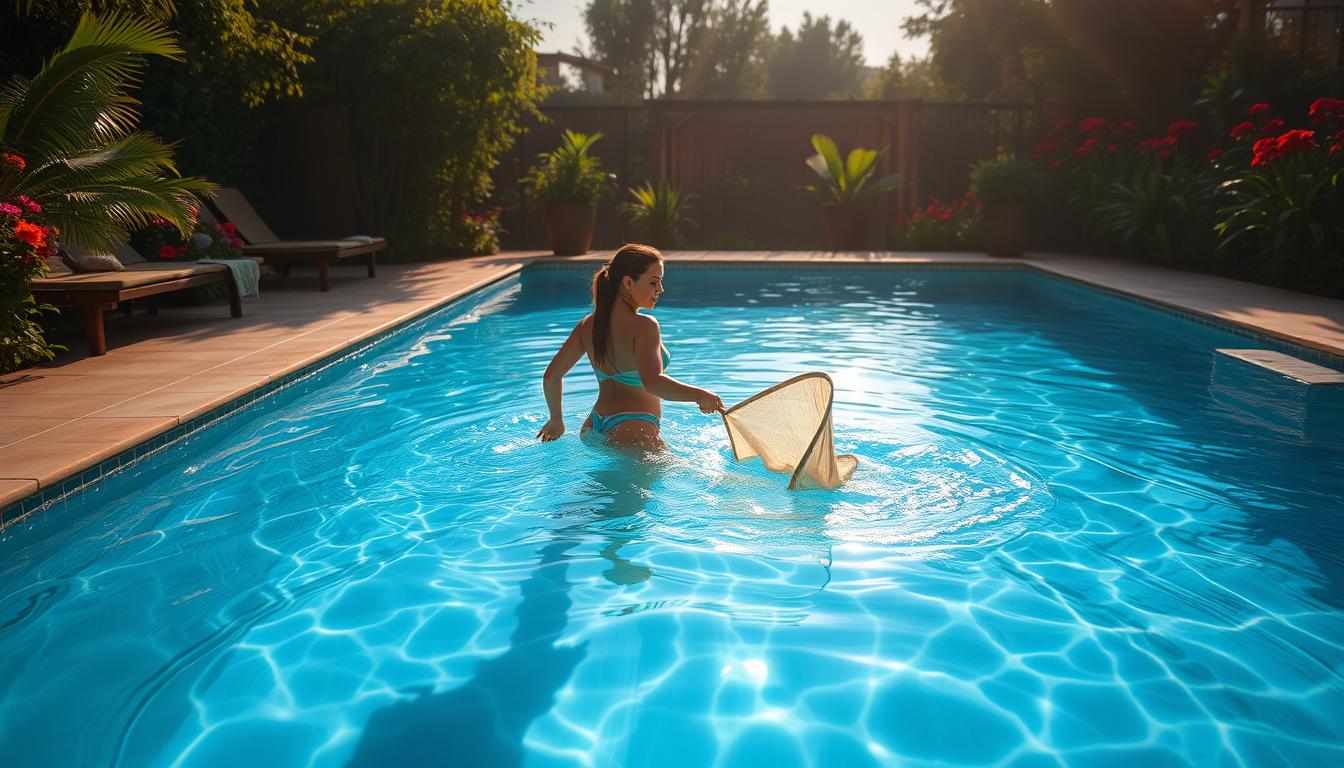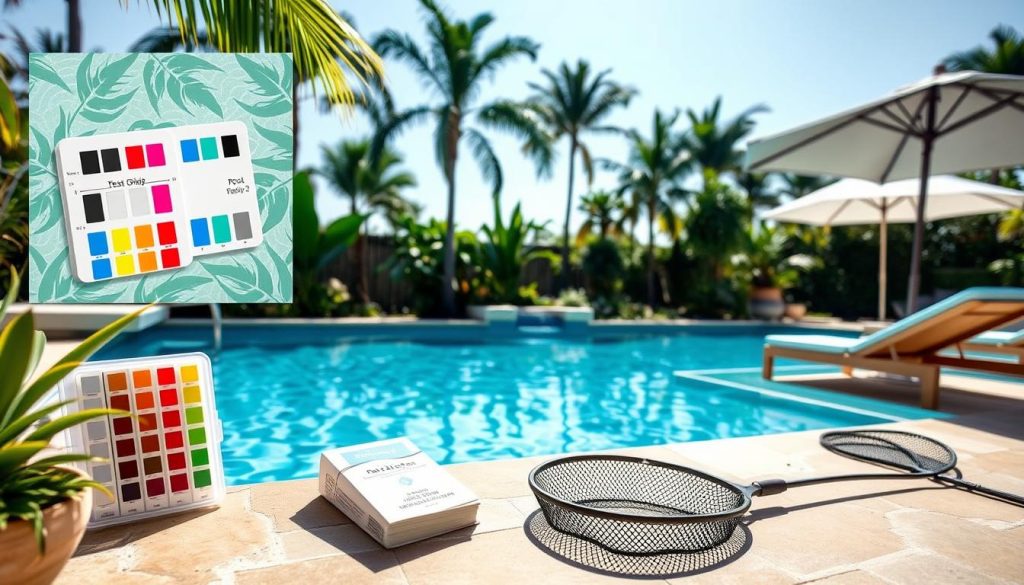
Saltwater pool ownership brings unique challenges and joys. Knowing when and how to shock the pool is crucial for maintenance. Sometimes, our salt chlorine generator needs extra help to keep the water clean.
Our first pool shock came after a busy weekend with guests. The water looked cloudy, prompting us to seek expert advice. We learned that shocking is vital for a healthy swimming environment.
Let’s explore how to shock a salt water pool effectively. We’ll share best practices for shocking and maintaining your salt chlorine generator. This guide will help both new and experienced saltwater pool owners.
Understanding the Basics of Pool Shocking
Maintaining proper pool chemistry is crucial for salt water pool owners. Pool shocking is key to eliminating contaminants and keeping water clean. Let’s explore the fundamentals of pool shocking for salt water systems.
What is Pool Shocking?
Pool shocking adds high doses of chlorine or oxidizing chemicals to pool water. This process destroys chloramines, bacteria, algae, and other unwanted substances. It restores water clarity and sanitization.
Salt water pool parts generate chlorine for the pool. However, occasional shocking is still necessary for optimal water quality.
Why Pool Shocking Is Essential
Contaminants can accumulate in your salt water pool over time. This can lead to cloudy water, unpleasant odors, and potential health risks.
- Eliminating chloramines, which are combined chlorine molecules that can cause eye and skin irritation, as well as a strong chlorine smell.
- Destroying bacteria, viruses, and other microorganisms that can pose health risks to swimmers.
- Preventing algae growth, which can turn your pool water green and cloudy.
- Maintaining proper chlorine levels, as the salt water pool system may not always generate enough chlorine to keep up with the demand.
Types of Pool Shock Treatments
Several options are available for shocking your salt water pool. Here are some common types of pool shock treatments:
- Liquid Chlorine: This is a popular choice for salt water pool owners, as it is easy to use and quickly raises the chlorine levels in the pool.
- Calcium Hypochlorite: Also known as cal-hypo, this granular shock treatment is fast-acting and effective at eliminating contaminants.
- Lithium Hypochlorite: This type of shock is known for its minimal impact on pH levels and its ability to dissolve quickly in water.
- Sodium Dichlor: This granular shock is stabilized with cyanuric acid, making it ideal for outdoor salt water pools exposed to sunlight.
- Non-Chlorine Shock: For those looking to avoid adding extra chlorine to their pool, non-chlorine shock treatments, such as potassium monopersulfate, can effectively oxidize contaminants without raising chlorine levels.
| Chemical Level | Optimal Range |
|---|---|
| pH | 7.4–7.6 |
| Total Alkalinity | 80–120 ppm |
| Calcium Hardness | 200–400 ppm |
| Cyanuric Acid | 30–50 ppm |
| Free Chlorine | 1–4 ppm |
Proper chemical levels ensure a safe and enjoyable swimming environment. Regular testing helps identify when to shock your pool. It also helps address potential issues before they become serious.
Do You Shock a Salt Water Pool?
Salt water pools require shocking, but less often than traditional chlorine pools. Understanding these differences is vital for proper salt pool maintenance. It helps ensure your pool components last longer.
Differences Between Salt Water and Traditional Pools
Salt water pools use a chlorinator to make chlorine from salt. Traditional pools need direct chlorine addition. This leads to key differences in upkeep and water chemistry.
- Salt water pools maintain a more stable chlorine level, reducing the need for frequent adjustments.
- The recommended salt level for a salt pool is typically between 2500-4000 ppm, while traditional pools do not require salt.
- Salt water pools have a lower chlorine level (1-3 ppm) compared to traditional pools (1-4 ppm).
- The pH levels in salt water pools tend to be higher, requiring more frequent monitoring and adjustment.

When to Shock Your Salt Water Pool
Salt water pools need less shocking than traditional ones. However, certain situations call for a shock treatment. These include opening your pool for the season and after heavy storms.
High pool usage can deplete chlorine levels, requiring a shock. Algae growth or cloudy water also benefit from shock treatment.
- Opening your pool for the season: Shocking helps eliminate any contaminants that may have accumulated during the off-season.
- After heavy storms or rainfall: Excessive water can dilute the salt and chlorine levels, necessitating a shock to restore balance.
- High bather load or heavy pool usage: Increased contaminants from swimmers can deplete chlorine levels, requiring a shock to maintain water clarity.
- Algae growth or cloudy water: A shock treatment can help eliminate algae and restore water clarity.
Use a shock treatment compatible with salt water pool chemicals, like sodium dichlor. Follow the maker’s instructions and ensure proper water circulation.
For the proper functioning of a salt chlorinator, the water temperature must be above 60-65⁰ F. It is recommended to run the pool pump for 24 hours to breakup stratification after the shock treatment.
| Parameter | Salt Water Pools | Traditional Chlorine Pools |
|---|---|---|
| Chlorine Level (ppm) | 1-3 | 1-4 |
| Salt Level (ppm) | 2500-4000 | N/A |
| pH Level | 7.2-7.6 (higher tendency) | 7.2-7.8 |
| Shocking Frequency | Less frequent | More frequent |
Regularly check salt water pool parts like the salt cell and flow switch. This helps maintain top performance and prevents equipment damage.
By understanding salt water pools and following best practices, you’ll have a clean pool. Your pool will stay clear and inviting all season long.
Best Practices for Shocking Your Salt Water Pool
Proper shocking is key for a clean, healthy salt water pool. Test the water first. Aim for a pH between 7.2 and 7.4. Alkalinity should be 80-120 ppm. This ensures the shock works well and protects pool parts.
Calculate shock needed based on pool size. Use 1-2 pounds per 10,000 gallons. Wear gloves and goggles when adding shock. Start the pump for good circulation. Spread shock evenly around the pool’s edge.
Shock in late afternoon or evening to prevent chlorine breakdown. Run the pump for 24 hours after shocking. Retest water before swimming to ensure safe chlorine levels.
Regular shocking keeps your pool in top shape. Brush and skim weekly. Clean the salt cell monthly. For issues, ask our team for expert saltwater pool troubleshooting help.







